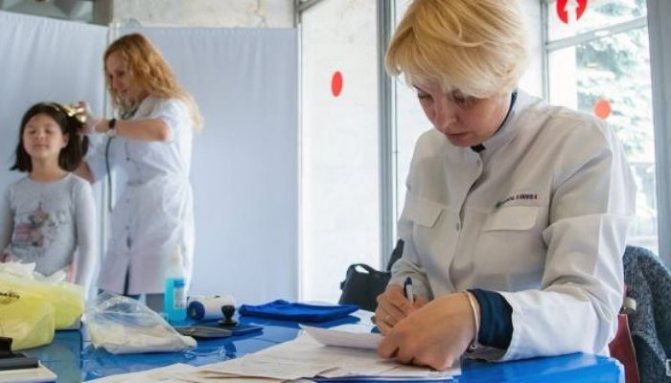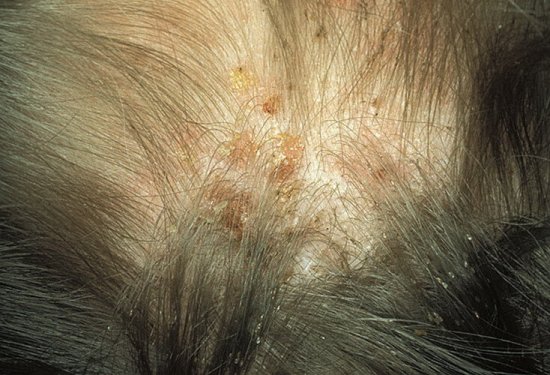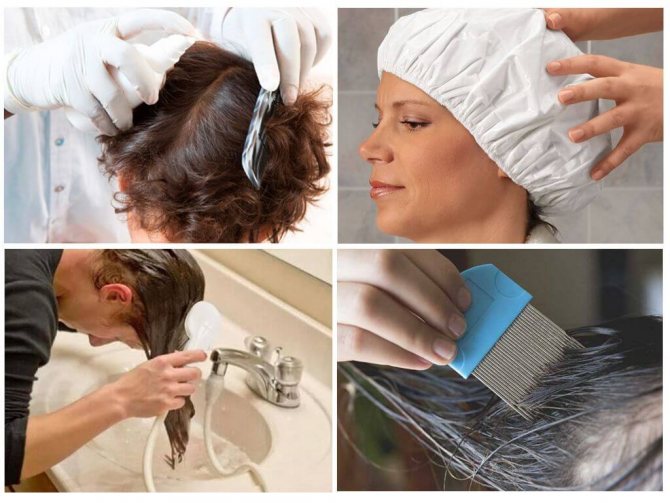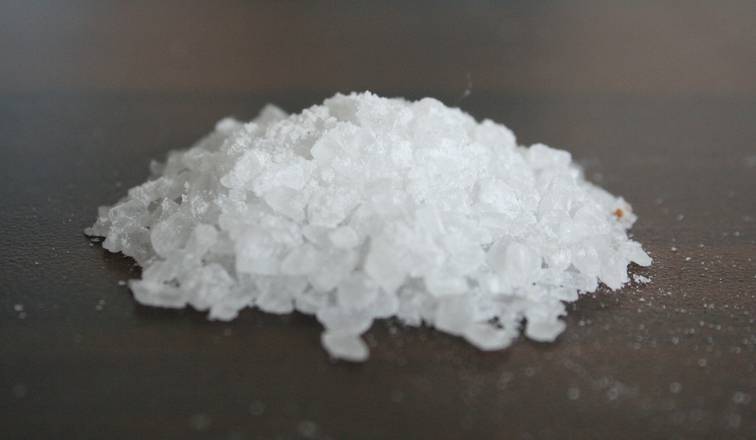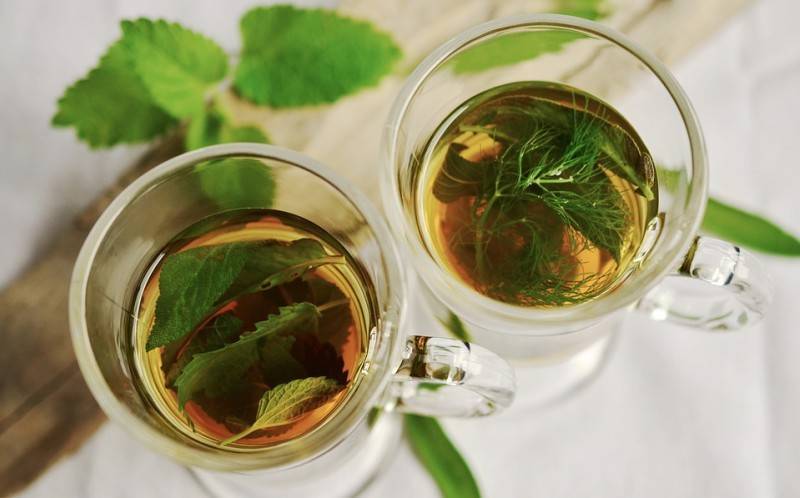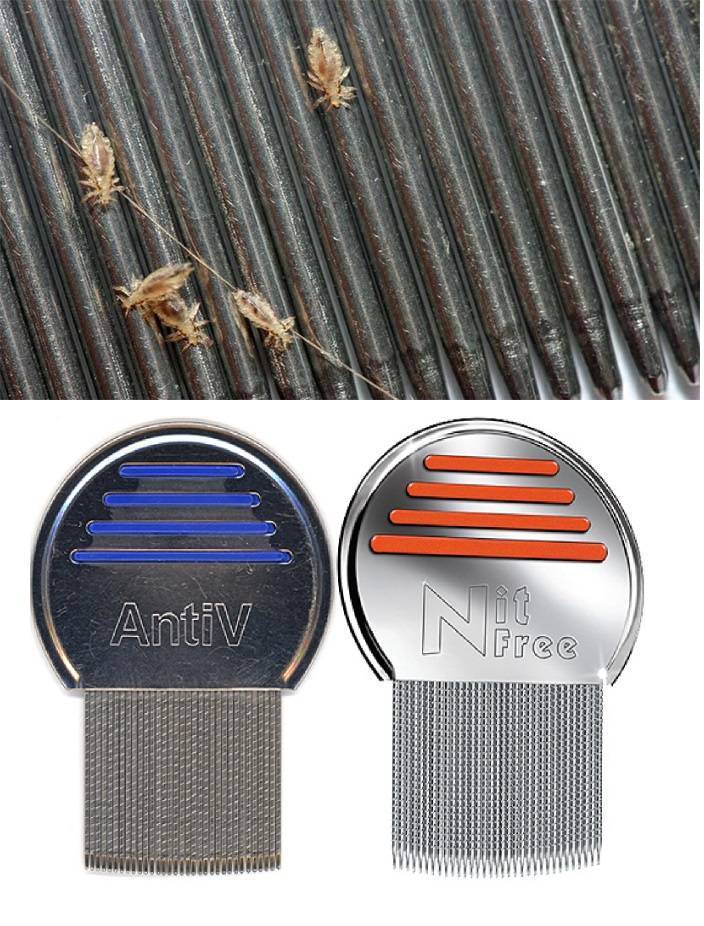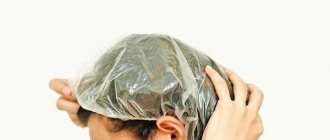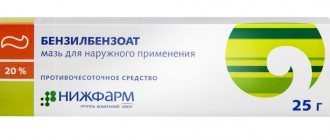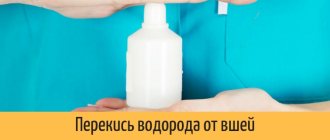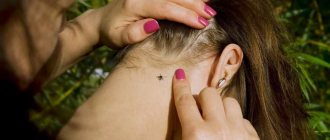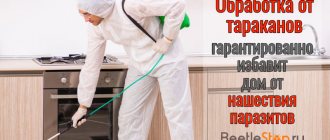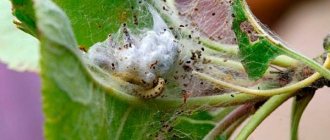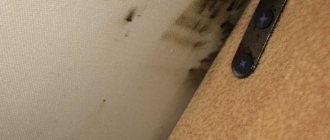(order No. 342)
purpose: elimination of lice and nits on the scalp (prevention of typhus).
Equipment:
1. Stowing of protective clothing and linen in a biksa - a medical gown, a kerchief, a mask, an oilcloth apron, gloves. Polyethylene kerchiefs - 2 pcs., Oilcloth drape, towels - 2 pcs., Cotton swabs, rod, shampoo, 6% vinegar solution, heated to 30 ° С; oilcloth bag, scissors, fine comb.
2. Hair burning basin, matches.
3. One of the disinsecticidal (pediculocidal) solutions:
a) 20% solution of benzyl benzoate or nittifor emulsion;
b) 0.5% solution of methylacetophos in equal amounts with acetic acid 6%
acid; c) 0.25% dicresil solution.
4. Clean underwear.
5. Patient's medical history or outpatient card and log of examination for head lice.
6. Emergency notification of an infectious disease.
Mandatory conditions: observe contraindications.
These include the treatment of pregnant women, women in labor, parturient women and nursing mothers, children under five years of age, patients with scalp diseases.
Carry out processing in a special, well-ventilated area.
Respect patient rights, confidentiality, infection safety.
Preparing for the procedure
1. Inform the patient about the presence of head lice and obtain consent for processing.
2. Put on an additional robe, scarf, slippers, gloves, mask, apron.
3. Sit the patient on a bed covered with oilcloth.
4. Cover the patient's shoulders with an oilcloth cape.
Procedure execution
1. Treat the hair with one of the disinsecticidal solutions according to the instructions for the disinsecticidal agent (for example, moisten the hair and rub in a 20% benzyl benzoate emulsion and leave for 30 minutes or nittifor for 40 minutes). Note: make sure that the product does not get into the patient's eyes, and the hair is evenly moistened.
2. Cover the patient's hair with a plastic kerchief, tie with a towel (20 min.).
3. Rinse hair with warm water, then with detergent, dry with a towel.
4. Treat the patient's hair with a heated 6% solution of table vinegar.
5. Cover the hair with a plastic kerchief, tie it with a towel for 20 minutes.
6. Rinse hair with warm running water, dry with a towel.
7. Comb your hair with a fine comb, tilting your head over white paper, sequentially dividing the hair into strands and combing out each section.
8. Re-examine the patient's hair. Make sure there are no lice or nits.
Didn't find what you were looking for? Use the search:
Best sayings:
You can buy anything for the scholarship, but not more.
8740 - | 7143 - or read everything.
91.146.8.87 <не является="" автором="" материалов,="" которые="" размещены.="" но="" предоставляет="" возможность="" бесплатного="" использования.="" есть="" нарушение="" авторского="" права?="" напишите="" нам="" |="" обратная="">
Disable adBlock! and refresh the page (F5)
very necessary
Lice are ubiquitous parasites. Having "picked up" insects, you should not hope that everything will be by simple washing your hair. Most likely, you will have to try a lot to put in order the patient, to prevent the spread of the disease. For this, the treatment of head lice should be carried out not only in the infected. It is advisable to provide preventive measures against lice for all family members living in the common area. Sanitation of tools, clothing, habitat is also an important condition for a confident victory in the fight against parasites. Let's consider the correct algorithm of actions for the disinfection of lice to be successful.
Nurse actions
In the admission department, special papers are filled out, an examination of the head, body, and personal belongings of the patient is carried out. Upon detection of live lice and nits, nits, the nurse conducts a thorough examination, determines the degree of infection.
If head lice is detected, it is necessary to fill in the table of a special journal. The nurse's tactics are aimed at destroying parasites, notifying relatives, obtaining the patient's consent to disinsection measures. If this is a child of preschool, school age, the heads of the educational institution are notified.
In the classroom, the group where the infected child is studying, the nurse conducts an unscheduled examination to determine the magnitude of the problem. Carries out preventive measures. The medical institution or SES notifies the results of the examination.
After detecting lice, filling in all the necessary documents, obtaining the patient's consent, he is transferred to a separate room where sanitization will be carried out.
It is contraindicated to carry out the procedure:
- children under 3 years old;
- pregnant women, lactating;
- patients in serious condition;
- in the presence of ulcers, wounds on the head.
In other cases, a nurse is obliged to carry out disinsection before admitting a patient for inpatient treatment.
Applied methods
Modern anti-lice treatment of a patient includes the following methods:
- Mechanical. They consist in the removal of parasites and their eggs by washing, combing or cutting the hair. In the past, hair removal was one of the most common ways to deal with lice. Nowadays, mechanical methods are most often used where it is impossible to use "heavy artillery" - chemical preparations, insecticides. They are used if a child, a pregnant woman, a severe allergy sufferer is infected with lice, as well as in the presence of extensive or deep skin lesions. Hair removal and combing is combined with rinsing with vinegar solution, which removes the "glue" and helps get rid of nits.
- Physical. These include mainly heat treatment, which aims to remove parasites from personal belongings. These are boiling, ironing with a strongly heated iron, steaming at high temperatures, as well as heating the hair with a hairdryer (used with restrictions).
- Chemical. These are the main ways to get rid of lice, since with the help of drugs, insects can be radically removed and relapses can be avoided.
We suggest that you familiarize yourself with: What is head lice and how does it arise? Pediculosis: symptoms, signs, causes in children and adults, home treatment with drugs from a pharmacy and folk remedies
The most effective technique is a combination of all three methods of exposure.
Pest control procedure
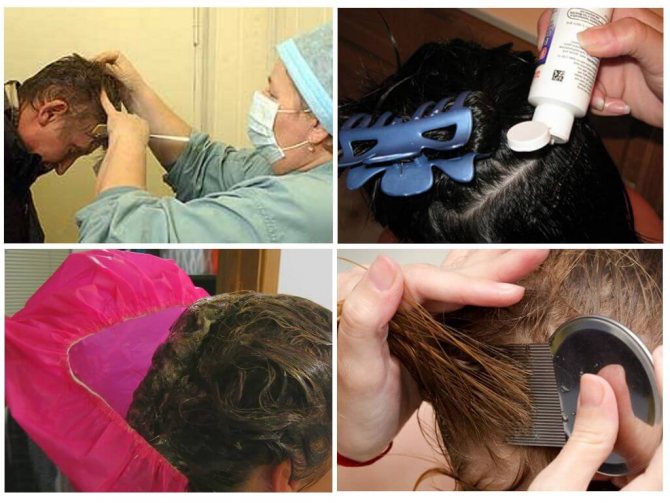
Hair treatment for head lice
- a couch, a chair, where hair treatment for head lice will take place, is covered with oilcloth;
- a dressing gown is put on the patient or a sheet is thrown over, a tourniquet from a scarf is tied along the hairline;
- the health worker puts on a gown, rubber gloves so as not to get sick;
- prepares everything you need - shampoo, head lice remedy, comb, vinegar, basin.
The treatment algorithm for head lice provides for the removal of head lice, combing out nits. Additionally, pest control of personal belongings is carried out. The room must be well ventilated. It is necessary to act as follows:
- Prepare a solution in the required amount according to the instructions.
- Hair is divided into strands, each is processed separately. Try not to get on the scalp.
- Long hair is wrapped in a bun.
- Put a plastic bag over your hair, or a special hat.
- Withstand the time necessarily according to the instructions.
- Wash off the composition.
- Prepare a solution with the addition of vinegar, rinse the hair, put on a plastic cap again, and leave for 15 minutes.
- Wash your hair again, dry it slightly with a towel.
The further treatment scheme for the patient provides for the combing procedure. Preparation consists in choosing a suitable place, the presence of a comb, medical alcohol.
- The patient is seated in a well-lit place.
- Lay out white sheets of paper.
- Remove dead lice and nits with a special comb with frequent, long teeth. Periodically cleaned with a cotton pad dipped in an alcohol solution.
The final result directly depends on the thoroughness of combing out the nits. After the end of the procedure, an examination is carried out again. It is recommended to re-treat the hair for lice after 14 days. This is done either in a hospital, if the patient stays in hospital for a long time, or already at home. It is also necessary to fill in the result of reprocessing.
Necessary tools and devices
The following materials and accessories are required for processing:
- two packs for medical personnel, including a dressing gown, gloves, kerchiefs;
- a cape or drape for a patient, a plastic and cotton kerchief;
- hair clipper, scissors;
- Shaver;
- a comb with often spaced teeth for combing out lice and nits;
- pelvis;
- bags - cotton and plastic;
- shampoo, soap;
- table vinegar;
- anti-lice remedy.
Actions with things
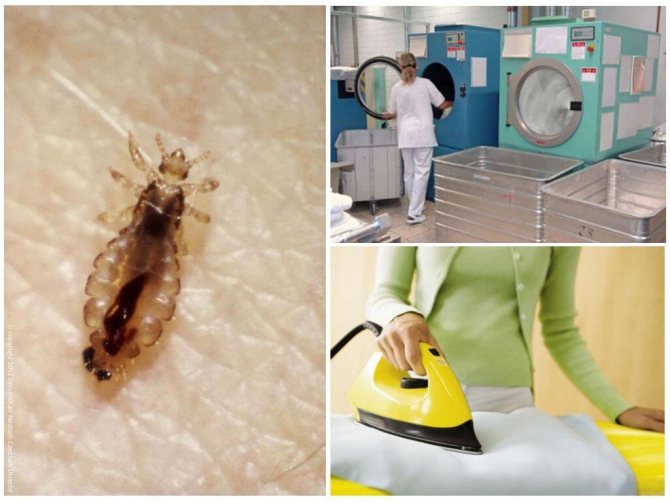

Treatment of things from parasites
The comb is thoroughly lubricated with alcohol. Rubber gloves are burned. Pest control of the premises. In the examination log, the nurse makes a record of the procedure. Assigns a second examination of the patient after 7 days.
When body lice are detected, hygiene procedures are carried out, things are sent for sanitation or for washing. If pubic lice are found, in addition to processing, consultation with a venereologist may be required.
Stages of sanitary and hygienic treatment of patients.
Sanitary treatment of the patient with pediculosis detected does not end after the disinfestation of hair and personal accessories. Since lice can easily spread, all of the patient's belongings and the nurse's clothes are packed in pre-prepared bags and sent to heat.
The comb, which was used to comb out lice and nits, is cleaned of insects and immersed in alcohol of at least 70 degrees of strength. All other tools are treated with vinegar and alcohol, if possible, doused with boiling water.
Cut and combed hair, parasites, consumables are carefully collected and disposed of by incineration.
• Examination of the patient's skin and hair.
• Cutting hair, nails, shaving (if necessary).
• Washing under the shower or hygienic bath.
Effective drugs
Revealing head lice is a mandatory procedure before placing the patient in the ward. If lice is found, the nurse must treat it. Lice preparations are provided by a medical institution or the patient buys at his own expense.
The nurse may suggest several options for the patient. The choice depends on financial capabilities, personal preferences, as well as on the presence or absence of individual intolerance to the components.
The nurse is required to perform a sensitivity test before starting the hair treatment. If redness, burning, itching, rash appears on the skin, it is prohibited to use the drug.
For the treatment of head lice, patients are prescribed Nittifor, Paranit, Medifox, Nyuda, Para Plus, Nyx. Or they are treated with an emulsion of Benzyl benzoate, dikresil.
The main manifestations of the disease
During the examination, the health worker can detect the following types of lice:
- head - on the hair of the head;
- wages (underwear) - on the body;
- pubic - on the pubis, under the arms, in the mustache, beard, eyebrows, eyelashes.


Signs of head lice:
- lice eggs glued to hair or strands of fabric;
- adult parasites or larvae;
- scratching and pustular crusts on the surface of the skin;
- itchy skin.
ANTI-PEDICULOSIS TREATMENT WITH INSECTICIDES - PEDICULOCYTES
- Destruction and mechanical removal of head lice and nits
- prevention of typhus, relapsing fever and Volyn fever
- For any degree of damage to head lice, pregnant women, women in labor, puerperas and lactating women, children under 5 years of age, persons with damaged skin (microtrauma, dermatitis, eczema, etc.)
- Slight infestation of people with head lice (1 - 10 specimens, including eggs - nits)
Treatment of the premises with head lice
- Prepare a well ventilated area
- Inform about the processing method and obtain consent to processing
- Wear protective clothing
- Tie the head with a towel or kerchief for the duration of the exposition
- Concentration and exposure strictly in accordance with the guidelines for use
- Disinfect the premises
- Take off protective clothing
- Wash your hands with soap
- Hand over things from a person with head lice for chamber disinfection
- Make a record of the processing in the card
- Register head lice in the Sanitary and Epidemiological Surveillance Center
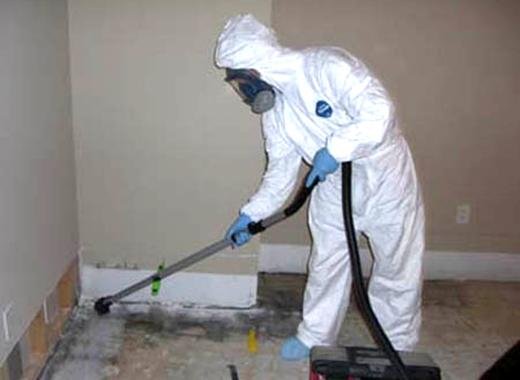

We work 7 days a week 6:00 - 24:00 Cash and bank transfer is possible
Treatment of living quarters from lice
A comprehensive approach to combating the disease helps to get rid of lice quickly and effectively. The processing of the premises includes the disinfection of linen, personal belongings, furniture, clothes, and so on. Combs are also subject to processing, otherwise the whole process of struggle will have to start over.
Treatment of things from lice and nits
Having found lice, many begin by treating the human body and consider this to be the main activity in the fight against parasites. In fact, these insects are more insidious than they seem, so at the same time it is necessary to disinfect things.
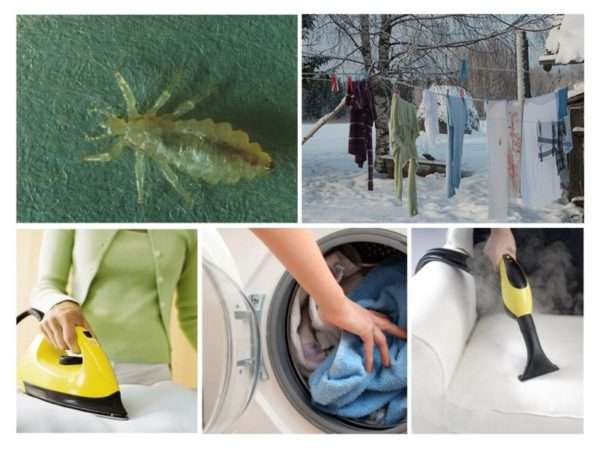

During processing, some rules are observed:
- Laundry must be washed at a high temperature before being processed. Boiling in a soda solution is most effective.
- Items that cannot be boiled should be disinfected in a specially prepared emulsion. It consists of kerosene and soap solution in equal proportions.
- Insects also die under the influence of low temperatures, so things can be placed in the freezer for a while or taken out in the frost in the winter season.
- Lice die in sunlight; it is enough to keep them in direct sunlight for about 14 days. The thermal effect is suitable for delicate fabrics and sensitive materials. Steaming and ironing are considered alternative cooking methods.
- It is best to pack soft toys in a bag immediately after treatment with a disinfectant and leave it there for at least 10 days. During this time, insects will die, and toys need to be washed.
- All combs in the house are subject to processing, as there may be nits that remain viable for up to 4 days. It is best to use special sprays for this, which can be applied to hats, hairpins, hair ties, and so on.
- Combs can be disinfected in a simpler way: make a solution of vinegar, peroxide and water in a 1: 1: 0.5 ratio, place objects in it and leave for at least three hours. After this time, remove from the solution and place in hot water, and after 15 minutes rinse with tap water.
- Lice combing is carried out several times a day. The same number of times you need to process combs, combs.
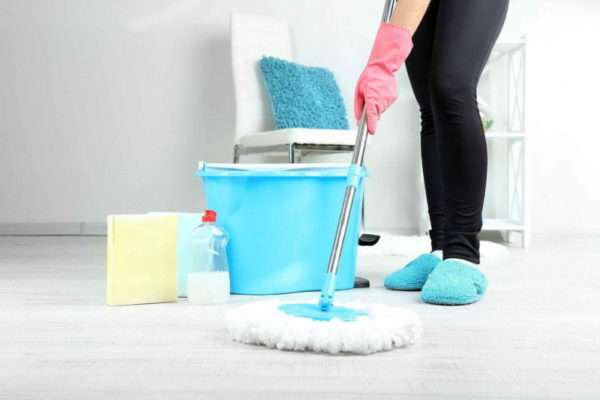

After processing personal belongings, they begin to disinfect the apartment.
Treatment of an apartment from lice and nits
To treat an apartment from lice and nits, it is best to invite employees of the Sanitary and Epidemiological Service. They will conduct this event in accordance with all the rules, and will also give the necessary recommendations for the prevention of the disease.
If desired and given time, similar processing can be carried out independently, observing the annotation to the disinfectant.
Before processing, preparatory measures are carried out:
- carry out wet cleaning of the room, and also burn all dead parasites found,
- bed and underwear are collected for washing together with other things and toys,
- vacuuming carpets,
- cosmetic and hygiene products are packed or covered with cellophane,
- it is better to remove all food products from the room,
- children, the elderly and pets leave the house during the treatment and return no earlier than three hours after disinfection.
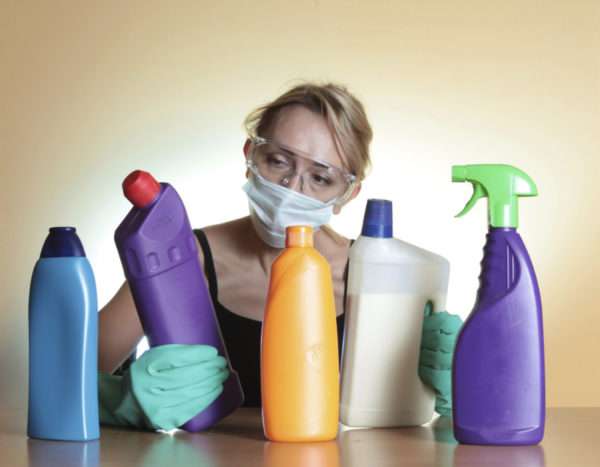

When self-pesting, the solution is prepared according to the instructions, strictly adhering to the recommendations
During processing, attention is paid to cracks in the floor and wall, baseboards, furniture, pillows, and so on. After the procedure, you need to ventilate the room well for 1.5 hours
Repeated wet cleaning is not required.
When processing, one should not forget about precautions, you should use respirators and rubber gloves. Clothes that have been disinfected must be washed
After a week after the event, a general cleaning is carried out to collect all dead insects and traces of the drug.
Two weeks after processing, a thorough cleaning of the room is repeated, all furniture sets and carpets are vacuumed.
How not to get infected:
Observe the rules of personal hygiene (washing the body at least once every 7 days with a change of underwear and bed linen; daily combing the scalp; washing bedding; regular cleaning of living quarters).
- Do not allow your child to use other people's combs, towels, hats, headphones, hairpins, hair ties - lice can be transmitted through these objects.
- Perform periodic hair and clothing checks on children in child care.
- Examine bedding carefully when traveling.
- After the holidays, be especially vigilant: conduct an examination of the child's head.
Modern means allow you to easily cope with head lice, so if head lice is found in a child, you must:
- purchase a remedy for the treatment of head lice at the pharmacy;
- process the scalp in accordance with the attached instructions;
- wash your hair using shampoo or baby soap;
- remove mechanically (by hand or with a fine comb) dead lice and nits;
- put on clean linen and clothes for the child;
- wash bed linen and things, iron with a hot steam iron;
- examine family members and yourself;
- repeat the examination of the child and family members within a month every 10 days.
Public prevention of head lice
Public prevention of head lice includes:
- Compliance with sanitary-technical rules in production.
- Strict observance of the sanitary and anti-epidemic regime in organized teams and medical institutions.
- Early identification of the patient (when seeking medical help and conducting primary and periodic scheduled medical examinations of organized groups of the population).
- Correct conduct of disinfection measures in hairdressing salons, laundries, beauty parlors.
- Providing institutions with the necessary amount of personal hygiene products, removable bed linen, detergents and disinfectants.
- Provision of medical institutions with the necessary disinfection equipment.
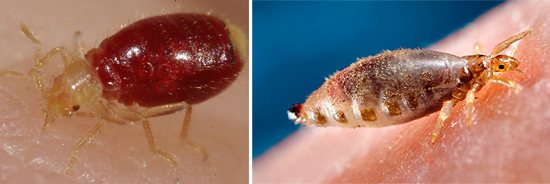

Fig. 7. Body lice fed on blood.
SOP on head lice. Sanitization rules for detecting head lice in a patient
| Name | Sanitization rules for detecting head lice in a patient |
| Anchor | SOP on head lice |
| date | 08.08.2019 |
| The size | 30.76 Kb. |
| File format | |
| File name | SOP on head lice .docx |
| A type | Documents # 84907 |
Selection according to the database: Methodology for the sanitary assessment of transport highways 2.odt, conducting a lesson according to general military regulations with a platoon specially, 16 rules for issuing ciz.docx, Basic rules for interpreting TN VED.docx, Write out rules for the Russian language.docx, Lecture 1 Sequence and rules for prepress .pdf, Lecture 1 Sequence and rules for prepress information, Lecture 2.4 Principles of information processing.doc, Synopsis No. 100 Labor protection rules when working at height (at, 62 Hand hygiene rules.doc.
Sanitization rules for detecting head lice in a patient
Pediculosis (pediculosis, lice) (from Latin pediculus, "louse") is a parasitic disease of the skin and its derivative - hair. Pediculosis is a specific parasitism on a person of lice that feed on his blood. Infestation (from Lat. infestare - to attack) - infection of the human or animal body with parasites (insects, ticks and other arthropods). A person can be parasitized by the head louse (Pediculus Humanus Capitis), the body louse (Pediculus Humanus Corporis) and the pubic louse (Phtyrus Pubis). Accordingly, there are head lice, head lice and pubic head lice. Mixed head lice can also occur when there is a mixed type of infestation (eg, simultaneous infestation of head and body lice). Lice feed on the host's blood, and eggs (nits) are glued to the hair (the body louse lays eggs in the folds of clothing, less often glues to the hair on the human body). Anti-lice measures - include a set of measures for the observance of sanitary and hygienic and anti-epidemic regimes in organizations, collectives and specific measures for the rehabilitation of people who have head lice.
| ||||||||||||||||||||||||||||||||||||||||||||||||
Who is subject to mandatory verification
Since lice infestation is a type of contact infection, timely detection of the source is necessary to prevent further spread.
According to the order of SanPiN, the check for head lice is of the following types:
- Scheduled, which is performed at a certain frequency.
- Unscheduled, the term of which is not set in advance. It is performed if a person infected with lice or nits is found in the team.
The following categories of people are checked:
- patients on inpatient treatment - once every 7 days, as well as upon admission;
- children and adult staff of kindergartens, homes and boarding schools - monthly;
- in schools, checks are carried out once a quarter (after the end of each vacation);
- in social security institutions - 2 times a month;
- other categories of workers - during routine medical examinations.
A person's condition can be checked by a therapist, family doctor, nurse, dermatologist or paramedic at a rural medical center.
You can carry out such a check at least every day, especially if there is a suspicion of the possibility of infection or there was contact with such patients.
The check is very simple and consists in examining hair and clothing under bright light and preferably using a magnifying glass. It is difficult to do this on your own, so it is better to involve an assistant.
Nits are easiest to spot as they are firmly attached at the base of the hair. Lice hide in the hair, so they may not be detected, especially in the presence of very thick and dark strands.
For work, the surface is covered with white paper or cloth, the hair is combed with a fine comb and check what can fall out of them. It is useful to check all parts of the body covered with hair, as well as the seams of clothing and underwear.
Algorithm for treating a patient with head lice
Lice belong to small blood-sucking parasites, which, depending on the type, are localized in the scalp, intimate areas, and on clothing. Due to the tiny size, it is impossible to identify bloodsuckers at the initial stage of the disease. At first, when the population is small, a person sometimes does not even know about the presence of lice. Because of this, pediculosis is often found in a medical facility or during emergency hospitalization at the initial admission. How do employees of medical institutions act in such cases, how is treatment for head lice carried out and whether the patient's consent to the procedure is needed.
Pediculosis prevention measures
To prevent the spread of infection in our country, a whole range of preventive and anti-epidemic measures has been developed and applied, including sanitary and hygienic, therapeutic and preventive and administrative measures.
- Preventive measures are aimed at preventing the spread of an infectious disease.
- Anti-epidemic measures are carried out in the focus of infection. They are aimed at localizing and eliminating it.
Primary prevention measures for head lice:
- Compliance with the rules of personal and public hygiene.
- Compliance with sanitary-technical rules in production.
- Compliance with the sanitary and anti-epidemic regime in organized teams and medical institutions.
Secondary prevention measures for head lice:
- Early detection of the patient (when seeking medical help and conducting primary and periodic scheduled medical examinations of organized groups of the population).
Tertiary prevention measures for head lice:
- Isolation of the patient.
- Timely started, adequate treatment of the patient with the obligatory control of the cure.
- Identification, examination and treatment (processing) of contact persons.


Fig. 5. In the photo there are pubic lice and nits.
In what cases is processing carried out
Detection of head lice usually occurs in the admission department at the sanitary inspection room. If it was possible to find adult lice and nits in the hair, an additional examination of personal hygiene items and the patient's belongings is carried out. The patient is transferred to a closed room and examined on a couch. The procedure for getting rid of lice is carried out in the inpatient department. Disinsection measures include comprehensive measures to destroy parasites in hair, body, and clothing.


Pediculosis
Contraindications for processing may be:
- children under 3 years old;
- pregnancy, lactation;
- serious condition of the patient;
- a large number of purulent wounds on the skin.
If head lice is detected, it is necessary to fill out the appropriate papers, in which the patient gives his permission to carry out the procedure. Lice preparations are allocated either from the medical fund or are purchased at the expense of the patient. The actions of a nurse in case of head lice are reduced to the preparation and conduct of sanitation, filling out a journal, the data in which is displayed in the form of a table, and notifying the patient's relatives.
In cases of detection of lice in children, the health worker informs the preschool or school institution. According to the new Sanpin for the prevention of head lice, an unscheduled examination is carried out in the class, the group, and preventive measures are taken to prevent the spread of lice.
Examination in the admission department of the hospital
A systematic examination in the emergency department for the presence of head lice is the best way to prevent this ailment. A person infected with lice, with regular contact with the same people, can very quickly transmit the parasites to them. It is for this reason that it is important to identify head lice as early as possible.
When is the inspection carried out?
Examination for pediculosis with a preventive purpose is necessary to detect the disease at the initial stage and to further stop its development. Checking is done by a doctor or nurse after a patient complains about a number of specific symptoms:
- The appearance in the scalp of lice and their eggs (nits).
- Unbearable itching, worse at night.
- Redness in the ears and back of the head caused by parasite bites.
- The appearance of small purulent formations on the scalp.
How processing is carried out
Sanitation is carried out in a separate room. It must be well ventilated. The nurse's tactics when performing disinsection is predetermined by the degree of infection of the patient, and therefore a treatment scheme for the patient is prescribed. Preparatory work involves a number of activities:
- cover the couch with oilcloth material and seat or lay the patient on it, after putting on a perlin and a tourniquet around the hairline;
- explain to the patient the process of the upcoming manipulation;
- the medical worker performing the procedure must put on an additional gown, gloves, mask and prepare all the necessary equipment: anti-pediculosis agent, hair clippers, a basin in 2 copies, bags for disposal and subsequent disinfection, a comb, vinegar.
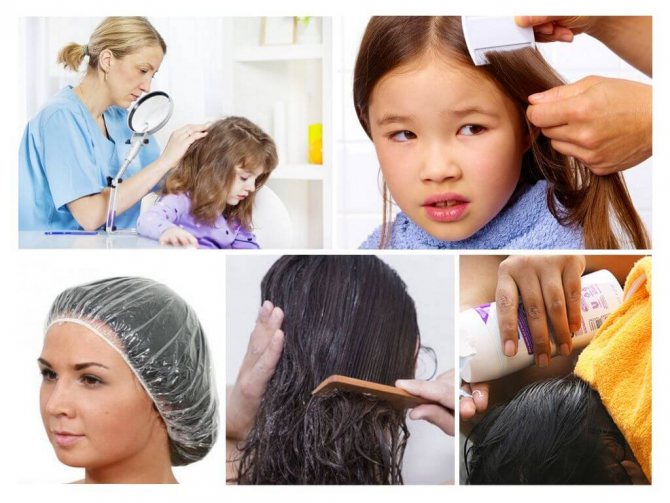

Anti-lice treatment
Treatment algorithm for head lice:
- Prepare a solution for the destruction of parasites in accordance with the instructions.
- Consistently treat hair from lice, avoiding contact with mucous membranes, face. Each strand should be processed separately.
- If the hair is long, collect it in a bun and cover it with a plastic kerchief.
- Maintain exposure according to the manufacturer's recommendations.
- After the specified time has elapsed, wash off the product with warm water, after removing the remains of the drug, wash your hair with a washing shampoo and rinse with a vinegar solution.
- After applying the vinegar solution, tie the hair with a plastic kerchief, leave it in this state for 15-20 minutes.
- Rinse hair again with warm water and towel dry.
- Place the patient on a chair, spread paper on the floor, so that later it will be easier to dispose of insects. Be sure to comb out dead insects and nits with a fine-toothed comb.
- Periodically remove adhering parasites from the crest with a cotton swab dipped in alcohol.
- At the end of the procedure, re-examine the patient and make sure that there are no lice and nits.
- If necessary, re-treatment of hair with head lice is prescribed.
How is sanitation carried out?
Preparatory stage
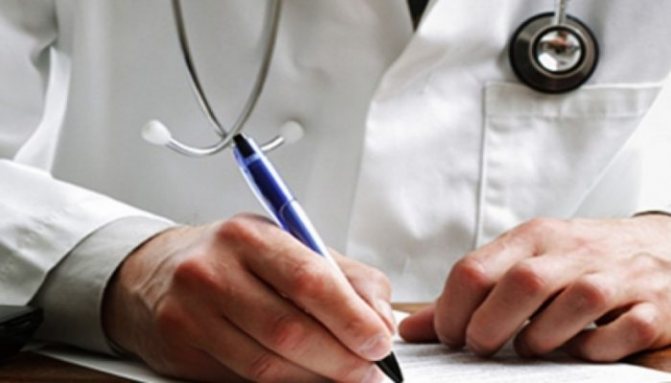

At this stage, the necessary equipment for disinsection is prepared, as well as the moral preparation of the patient. In general, preparation is carried out in the following actions:
- Explaining to the patient the essence of the disinsection procedure and obtaining his approval for sanitization.
- Preparing the nurse for the procedure, which consists in the additional putting on of a special gown, apron and medical gloves.
- Preparation of the procedure site. Oilcloth is spread on the floor, a chair or couch is prepared for the patient.
- Patient preparation. An apron is put on the patient, and his shoulders are covered with a waterproof cape. Preparation of a towel to protect the eyes from pediculicidal agents.
- Preparation of pest control products.
Failure to follow any of these points could harm the patient or nurse during the procedure.
Disinsection measures
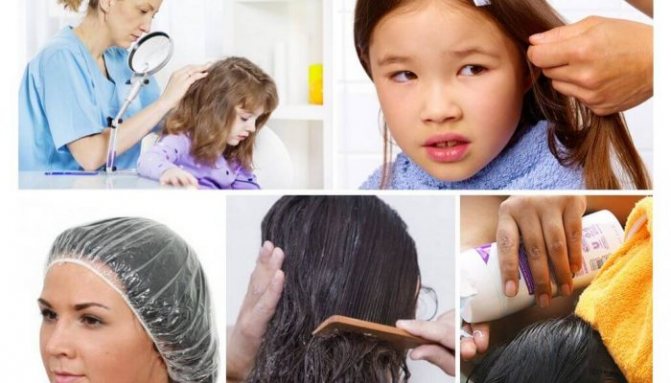

After the preparatory process, the nurse proceeds directly to conducting disinsection measures (destruction of parasites and nits).
Algorithm for sanitizing the scalp:
This parasite killing technology is basic. In medicine, there are many other methods for eliminating lice.
Completion of sanitation
After the end of the direct procedure for the destruction of lice, the following steps are taken to complete the course of treatment:
- Dissection of personal clothing and underwear of the patient.
- Handling the nurse's gown and apron, washing hands thoroughly.
- Repeated disinsection after a week if lice are found again.
In some cases, with the consent of the patient, a short haircut is possible. The removed hair is then collected in a special bag and burned.
The final stage
- burn the paper over which the combing was carried out;
- take off the patient's clothes, underwear and put them in an oilcloth bag, carry out the same manipulations with the nurse's clothes, who was involved in the treatment;
- send the bags to the disinfecting chamber;
- treat the comb with alcohol;
- carry out the treatment of the premises with an insecticidal preparation.
At the end of the procedure, the nurse must fill out the head lice examination log, make an appropriate note in the patient's outpatient card. Re-examination is carried out after 7 days, if necessary, additional processing is performed.
In cases of detection of body lice, hygiene procedures are prescribed, and all the patient's belongings are subject to heat treatment. It is recommended to sanitize the apartment. After the parasites are removed, the medical worker conducts explanatory conversations so that the patient cannot get sick with head lice again.
Indications for examination
In places where a large number of people are concentrated (hospitals, educational or correctional institutions, military units, industrial enterprises), routine examination for head lice is the responsibility of medical workers. According to the approved rules and regulations, the following contingent must be checked for lice:
- children permanently living in closed institutions such as boarding schools;
- babies who are registered in kindergarten for the first time or return to groups after being absent for a week or more (parental leave, illness);
- children going on vacation to health camps;
- persons in temporary detention facilities or correctional colonies;
- adults and children entering inpatient or sanatorium treatment.
People who wash their hair often are more vulnerable to head lice, and their skin is especially prone to lice bites.
On an outpatient basis, routine checks are carried out by a nurse, their frequency is determined by the age category:
- preschool children - once a month (organized kids are examined in kindergartens, unorganized ones - when visiting a health worker at home or in a clinic);
- schoolchildren - after every vacation;
- adults - when a person actively contacts a polyclinic, when lice are found in family members, when drawing up a sanatorium card or an extract from an outpatient card.
An unscheduled check for head lice is carried out when cases of the disease are detected in kindergarten groups, school classes and other teams.
Treatment for head lice, how to do everything right and not miss anything
Lice are ubiquitous parasites. Having "picked up" insects, you should not hope that everything will be by simple washing your hair. Most likely, you will have to try a lot to put in order the patient, to prevent the spread of the disease. For this, the treatment of head lice should be carried out not only in the infected. It is advisable to provide preventive measures against lice for all family members living in the common area. Sanitation of tools, clothing, habitat is also an important condition for a confident victory in the fight against parasites. Let's consider the correct algorithm of actions for the disinfection of lice to be successful.
Head lice detection and disinsection - detailed algorithm
The algorithm for examination for head lice includes the following actions:
- Examination of the scalp. Hair needs to be loosened and combed. They are examined with a magnifying glass under a very bright light, the hair roots, where the nits are attached, are especially carefully examined, and the presence of papules - traces of parasite bites - is also checked. The examination is started from the back of the head and the area behind the ears.
- Examination of the skin on the body. If the patient has body lice or pubic lice, traces of them can be found in the form of bites and scratches, as well as nits that are attached to the hairs.
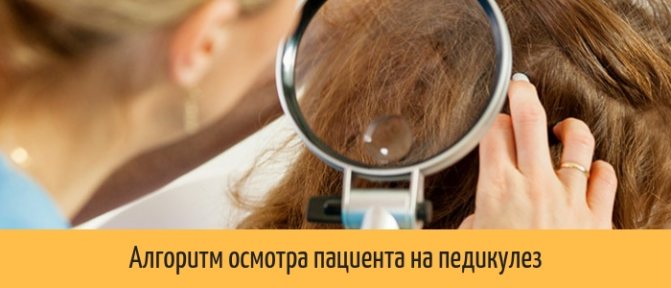

The examination is carried out with gloves, which are then discarded using a comb or comb with long and long teeth. The floor is pre-covered with a cloth or oilcloth. The comb is sterilized with alcohol after work.
Expert opinion
Semenova Victoria Viktorovna
Doctor of San Epidem Station. Moscow
It is not enough to check only the hair and body; you also need to check the clothes, because lice can leave nits in the seams.
Complete processing: when and why is it needed
It is advisable to carry out full treatment for head lice in all cases when a head lice problem is identified. Sanitation of the patient, things, surrounding space will help get rid of parasites faster. Comprehensive measures will significantly reduce the risk of re-infestation of lice. Being in the risk zone is a reason to think about introducing such actions on a regular basis. They will be an excellent prevention of disease.


Unsanitary conditions, crowded living conditions, irregular (poor-quality) washing, a rare change of clothes, a predisposition to close contact with strangers is a reason to think about protection from parasites. This applies to permanent and temporary similar conditions. For example, the return of the child from the summer camp is a reason to strengthen control, to carry out the prevention of head lice.
What to do if the lice were taken out, but the head still itches
In some cases, even after completing the full course of treatment, itching still remains. The reasons may vary. It is sometimes impossible to find out on your own, since the head may begin to itch even a few months after the lice have been removed.
Repeated itching may appear when:
The appearance of allergic reactions to the agents that were used for treatment, as well as to the bites of the insects themselves. Itching due to bites can occur even several months after getting rid of head lice. Sometimes it is accompanied by a rash on the head and neck. To cope with the problem, you need to take antiallergic drugs. They must be prescribed by a doctor. Re-infection. When scratching the bites, sores may appear in their place. It is through them that an infection can enter the body when combing. In this case, inflammation of the hair follicles is observed, the general condition worsens, appetite decreases and body temperature rises, lymph nodes may increase. In the presence of such symptoms, an urgent need to consult a doctor. Incomplete lice removal. Sometimes, after a course of treatment, nits still remain on the child's head. If the head continues to itch, then a careful examination should be carried out.
It is important to do this in good lighting conditions. If lice or nits are found, re-treatment of the head will be required. Overdrying of the scalp
This condition can be a side effect when using some drugs. With such a problem, you need to take measures aimed at improving the condition of the skin. First, you can rinse your hair after each wash with an apple cider vinegar solution. Secondly, once a week you can rub burdock oil into the hair roots. You can also use baking soda to combat dryness. To do this, 1 tsp of this substance must be mixed with a small amount of water until a pasty consistency is formed. It should be applied to the scalp for 15 minutes, and then rinsed with warm water.
Processing technology: family members, things, home
To completely get rid of parasites, peace of mind, treatment of an apartment when head lice is detected is simply necessary. The procedure includes disinfection of all contact persons, things, and the surrounding area. This is necessary to completely get rid of parasites, which, even in a short period of time, could crawl onto third-party objects, people.
Note! Treatment at home is carried out independently or with the participation of an insecticidal profile organization. A specialized service will offer the services of experienced craftsmen with an arsenal of necessary chemicals.
Disinfection includes several stages:
- patient treatment;
- cleaning tools;
- washing clothes, household items;
- sanitation of the surrounding space.
Each action is important to obtain an effective result, but for a holistic view of technological processes, it is necessary to consider them in more detail.
Patient treatment
Treatment of head lice in humans is carried out according to the instructions for the selected drug. It is advisable to carry out the process in a well-sanitized room (at home, this is a bathroom). The creation of conditions for forced ventilation is necessary when working with insecticides.
When lice are detected, the treatment of the patient is carried out using a disposable cape on the shoulders of the infected person, an additional gown, gloves, and a scarf for the person who is sanitizing.
After the procedure, things are washed (burned, thrown out in a tightly packed bag). When working with toxic insecticides, it is advisable to use a respirator mask.
The procedure is carried out as follows:
- wash the patient's head;
- a medicinal product is used;
- after the allotted time, the hair is washed;
- perform mechanical combing out.
After all the manipulations, a thorough refurbishment of the premises is required. This is a kind of protection against lice. You will find detailed instructions on the use of popular and effective remedies for lice and nits on our website.
Cleaning tools
Instruments should be washed as soon as they become dirty during the treatment process. This is a guarantee of exclusion of re-infection when sanitizing for head lice.
It is recommended to carefully observe the accessory of the instruments. Healthy family members should have their own combs. It is even desirable to store them away from the objects of an infected relative.
Disinfecting washing of tools after lice is also carried out after complete cure (applies to all combs in the house). This will help avoid unexpected relapses.
The processing options are as follows:
- the use of any toxic agent designed to combat lice (spray, shampoo, solution);
- the use of a homemade composition (vinegar, hydrogen peroxide, ordinary water in a ratio of 1: 1: 0.5);
- scalding with boiled water (the material of the device should allow).
An important point! In addition to tools, accessories from everyday life are sanitized from lice: hairpins, elastic bands, ribbons. Use the same solutions. The treatment of things from lice is as follows: jewelry is placed in the composition for 3 hours, then rinsed with hot water (60-70 degrees), washed with soap (shampoo).
Washing clothes
Cleaning of clothes, bed linen, and other textile accessories is a must. Particular attention is paid to the period of active treatment. Parasites can creep onto textiles. Using dirty utensils will ensure re-infection.
All textiles in contact with the patient are washed. It is advisable to boil things made of cotton. Adding soda solution will enhance the effect. Treatment of linen with head lice is carried out at the highest possible temperature.
Linen that has temperature limitations during washing is sanitized with a solution based on soap and kerosene (1: 1). Items are placed in the composition for 20-30 minutes, then washed in accordance with the required thermal restrictions.
Lice are sensitive to extreme high and low temperatures. Frost or scorching sun are good disinfection options. In winter or summer, washed items are taken out into the open air for several days. An alternative option would be to use a freezer, iron, steam generator. It is necessary to ensure that the textiles allow such processing.
Large items (pillow, mattress, bedspread), children's toys are hermetically packed in polyethylene, wait 10 days. During this time, all viable individuals will die. Finally, it is advisable to wash these items (if possible). The best option is to replace them with new ones. A good choice, especially in the case of excessive contamination, is to use a dry cleaning service. The method will be ideal for disinfecting things with head lice.
Particular attention should be paid to clothing in which treatment is performed. This applies to the belongings of the patient, family member, performing insecticidal actions.
Cleaning the house
In addition to the obligatory washing of textiles, treatment of lice and nits at home will be required. The room is subjected to standard wet cleaning. Then, all surfaces are disinfected with an insecticide. The emphasis is on objects that can provide shelter for insects:
- carpets;
- upholstered furniture;
- textile toys.
Processing should be carried out in an empty room (without the presence of household members), using personal protective equipment (respirator). After disinfection measures wait several hours (3-5 is enough). It is forbidden to be in the house at this time. Then, the room is well ventilated. The collected garbage is thrown out in a tightly tied bag.
A week after the initial treatment, the activities are repeated. Thanks to this, the maximum effect is achieved, the prevention of recurrent infection.
Complete treatment for lice is an important condition for a quick treatment result. Refusal of any stage of complex measures - the risk of re-infection in your home, doom others to illness.The only way to finally eradicate the problem is by taking a serious approach to business.
Self-test at home
Clinical picture
What doctors say about parasites
Doctor of Medical Sciences, Professor Gandelman G. Sh .:
I have been detecting and treating parasites for many years. I can say with confidence that almost everyone is infected with parasites. It's just that most of them are extremely difficult to detect. They can be anywhere - in the blood, intestines, lungs, heart, brain. Parasites literally devour you from the inside, at the same time poisoning the body. As a result, numerous health problems appear, shortening life by 15-25 years.
The main mistake is procrastination! The sooner you start removing parasites, the better. If we talk about drugs, then everything is problematic. To date, there is only one truly effective antiparasitic complex, this is. It destroys and sweeps out all known parasites from the body - from the brain and heart to the liver and intestines. None of the drugs existing today are capable of this.
Within the framework of the Federal program, upon filing an application until October 12. (inclusive) each resident of the Russian Federation and the CIS can receive one pack of Toximin IS FREE!
Lice can be found on their own without going to the hospital. To identify head parasites at home, you need:
- Comb dry or wet hair with a simple comb.
- Take a comb with frequent teeth and work through the strands, starting from the scalp, examining the teeth after each pass.
- Lice are easy to identify visually - they are insects of indeterminate color with a flat body, which will remain on the comb.
- People with thick hair can do a self-test by dampening the strands with a little vegetable oil - this makes it easier to comb them with a fine comb.
Sometimes dandruff or dirt can be mistaken for lice, so it is best to use a magnifying glass during self-examination.
Trofimova Irina
Don't understand the article or need help? Ask a question now and get an answer.
auto RU
To diagnose pubic lice (phthiriasis), it is not necessary to look for insects: it is enough to find dark or bluish spots on the skin of the pubis, lower abdomen or inner thighs.
A common symptom of phthiriasis is itching at night in the anal and genital area. It is necessary to examine, using a mirror, the skin and hair in the pubic area. The eggs of the parasites will appear as small, whitish formations. Usually nits are located near the base of the hairs.
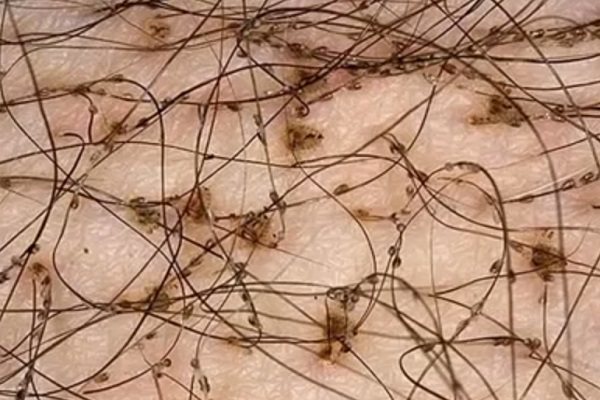

The lice themselves will move nearby. In addition to pubic hair, you need to carefully examine the armpits, eyebrows and eyelashes in the mirror - there may be nits on them.
Body lice removal measures
- the patient is subjected to a hygienic procedure using a detergent and a washcloth;
- bedding, clothes are boiled in a solution of soda ash or treated with disinfectant solutions of karbofos, neopin dust, special attention is paid to folds, seams, pockets where parasites like to live;
- processed items are ironed on both sides with a hot soleplate.
Prevention in an infectious diseases hospital is reduced to the timely detection of lice in incoming patients. The infected patient is placed in an isolated ward, in which he is kept until the treatment of head lice is carried out. In cases of mass foci of infection, a quarantine regime is introduced.
Lice symptoms
The main signs indicating a parasite infestation are:
- scratching on the head from severe itching;
- swelling of the skin at the site of the bite;
- melasma - redness of the area of the bites;
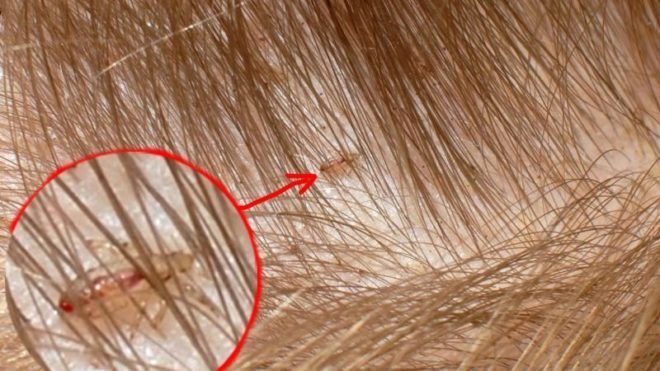

The bite sites do not heal for a long time, since the lice secrete an enzyme that increases the blood clotting time.
Without nutrition, the life cycle of a louse lasts:
- wardrobe - up to 10 days;
- head - day;
- pubic - up to 12 hours.
Chemerichnaya water for head lice
Chemerichnaya water is sold in pharmacies and is an aqueous solution of an alcoholic tincture of the medicinal plant Chemeritsa Lobel.
The drug poisons lice quite effectively, but it can also harm a person. Chemerichny water corrodes the skin and irritates the respiratory tract. It must be used with great care.
Chemerichnaya water is capable of killing not only already hatched lice, but also their nits. It penetrates the outer shell of the egg and dries it out from the inside. But there is no guarantee that all parasites will be removed after a single use of the product .. Most likely, you will need to repeat the treatment several times at intervals of 1-2 weeks.
Lice remedy: hellebore water.
Anti-lice therapy with hellebore water is carried out as follows:
- wash their hair with shampoo
- moisten a cotton swab in the preparation
- a swab is used to treat the scalp and hair shafts
- put a plastic bag or cap on your head
- after half an hour, wash your hair again with shampoo
After the procedure, the hair must be combed out.


